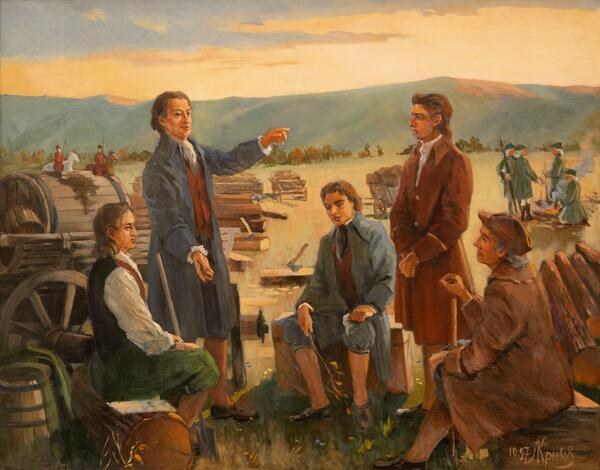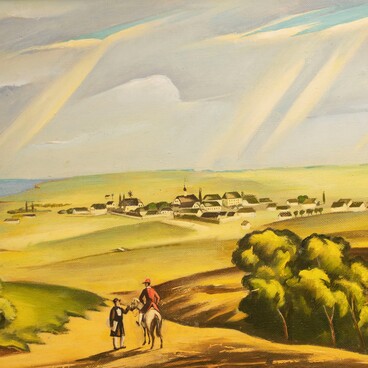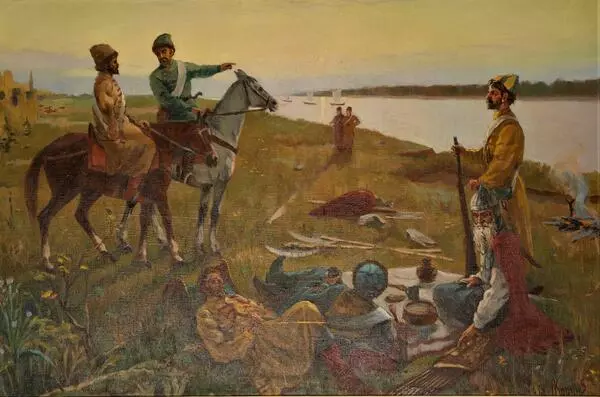The artist Lev Krylov depicted the first brothers-Hernguters, who arrived at the site of the foundation of the new colony. The brothers were accompanied by a convoy of Don Cossacks, soldiers of the Tsaritsyn garrison and Saratov military surveyors.
It is the soldiers and Cossacks who are depicted in the background of the picture. The colonists, attentively listening to the sermon and performing evening prayers are in the center of the composition. They are serious and focused, realizing that it will not be easy to establish a settlement in these wild places.
In 1762, Catherine II published the Manifesto on permit for foreigners of any religion to settle in the southern outskirts of the Russian empire. This was done for the purpose of settling and economic development of the empty territories of the south and southeast of Russia, as well as protecting them from the raids of nomads. One of the first to respond to this call were the German Hernguters - representatives of the Protestant movement, descendants of the so-called Czech or Moravian brothers.
The leader of a small expedition, which was to prepare a place for the founding of the colony, was Daniel Heinrich Fick, appointed a presbyter, that is, the head of the community. Together with Christian Rebel - a carpenter, Niels Hoy - a peasant from Estland (the territory of modern Estonia), Ludwig Broberg - the son of a Swedish prisoner of war, born in Tobolsk, and Jacob Breu - a weaver from Thuringia (land in the eastern parts of modern Germany) Heinrich Fick left Germany to the place of the new settlement.
In mid-April 1765, the settlers took off and on June 1 they arrived in St. Petersburg. There Fick was approved as abbot and foreman of the future colony. Further, the brothers' path ran through Kazan, Saratov and Tsaritsyn (the former name of Volgograd).
On August 12, the expedition arrived in TsarItsyn and immediately set about searching for a plot of land suitable for founding a village. Four days later, they chose a place on the banks of the Sarpa River in 28 versts - about 30 kilometers - south of Tsaritsyn and designated it as the center of the future colony. Already on September 3, 1765, they left for a new place to begin work on the foundation of the settlement. Since then, this day has always been celebrated in Sarepta as a holiday of the founding of the colony.
The German colonists had a completely false idea about the state of nature of the Volga land. Instead of the expected dense forest where it would be necessary to cut down a clearing for a new village, the colonists discovered vast steppes. On the chosen land they found only small oak groves, and there were some shrubs on the island located in front of the mouth of the Sarpa, so they had to deliver construction materials from afar.
By September 14, 1765, the foundations of the first house of Sarepta were laid in the new place. Closer to winter the house built of oak logs appeared.
It is the soldiers and Cossacks who are depicted in the background of the picture. The colonists, attentively listening to the sermon and performing evening prayers are in the center of the composition. They are serious and focused, realizing that it will not be easy to establish a settlement in these wild places.
In 1762, Catherine II published the Manifesto on permit for foreigners of any religion to settle in the southern outskirts of the Russian empire. This was done for the purpose of settling and economic development of the empty territories of the south and southeast of Russia, as well as protecting them from the raids of nomads. One of the first to respond to this call were the German Hernguters - representatives of the Protestant movement, descendants of the so-called Czech or Moravian brothers.
The leader of a small expedition, which was to prepare a place for the founding of the colony, was Daniel Heinrich Fick, appointed a presbyter, that is, the head of the community. Together with Christian Rebel - a carpenter, Niels Hoy - a peasant from Estland (the territory of modern Estonia), Ludwig Broberg - the son of a Swedish prisoner of war, born in Tobolsk, and Jacob Breu - a weaver from Thuringia (land in the eastern parts of modern Germany) Heinrich Fick left Germany to the place of the new settlement.
In mid-April 1765, the settlers took off and on June 1 they arrived in St. Petersburg. There Fick was approved as abbot and foreman of the future colony. Further, the brothers' path ran through Kazan, Saratov and Tsaritsyn (the former name of Volgograd).
On August 12, the expedition arrived in TsarItsyn and immediately set about searching for a plot of land suitable for founding a village. Four days later, they chose a place on the banks of the Sarpa River in 28 versts - about 30 kilometers - south of Tsaritsyn and designated it as the center of the future colony. Already on September 3, 1765, they left for a new place to begin work on the foundation of the settlement. Since then, this day has always been celebrated in Sarepta as a holiday of the founding of the colony.
The German colonists had a completely false idea about the state of nature of the Volga land. Instead of the expected dense forest where it would be necessary to cut down a clearing for a new village, the colonists discovered vast steppes. On the chosen land they found only small oak groves, and there were some shrubs on the island located in front of the mouth of the Sarpa, so they had to deliver construction materials from afar.
By September 14, 1765, the foundations of the first house of Sarepta were laid in the new place. Closer to winter the house built of oak logs appeared.







